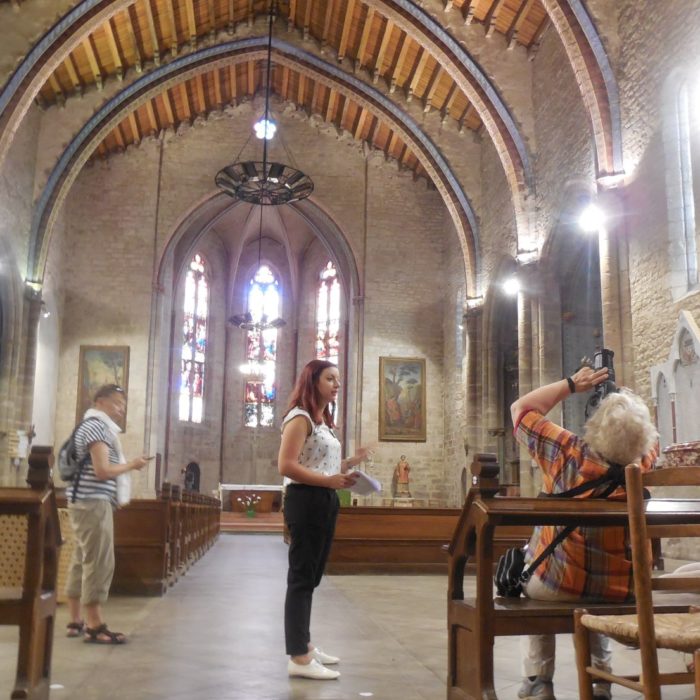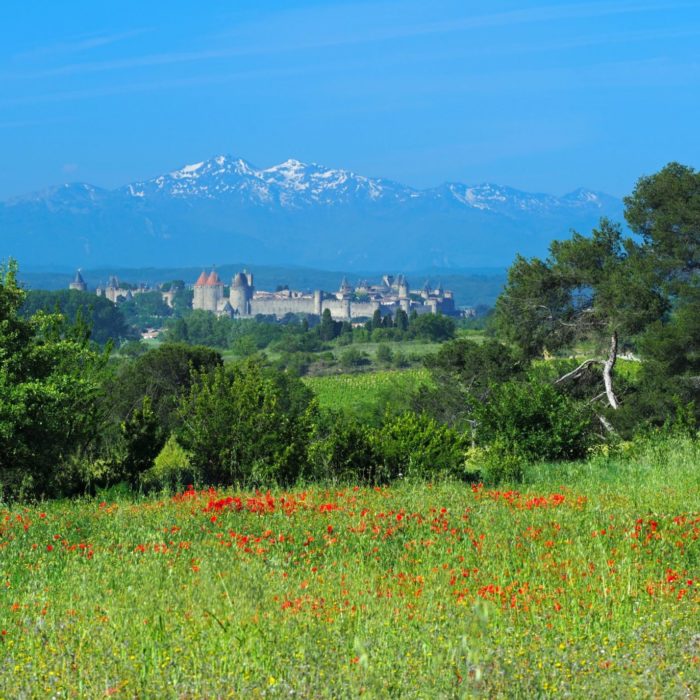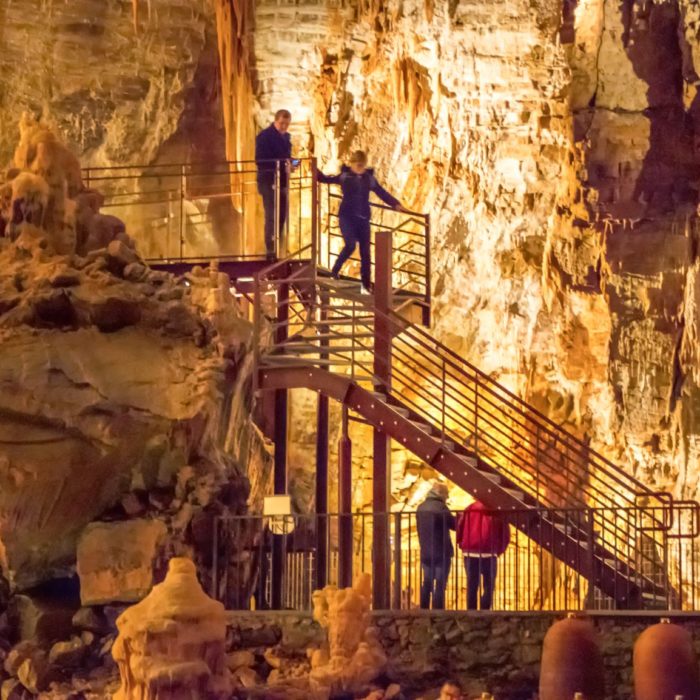Aragon... a village 'capitelle' letters
Aragon, first of all, is as pretty as a picture. Arriving via the road from Pennautier, at the top of a hill, you see below you Aragon, a small climbing village, like an island, triumphant over the vines, with the church of Sainte Marie, at the highest point, like a lighthouse. A photo is a must!
Then, you walk through the steep streets. You have wonderful views over the unspoilt, natural setting. You reach the top of the hill to visit the church of Sainte Marie, with its medieval Gothic style and painted ceilings. You can visit the dry stone of the area, setting off on one of the discovery trails to discover the solitary cabins, known as capitelles. And for the more athletic, you can get on your MTB and ride on one of the many circuits provided by the largest club in France.
Saint-Martin-le-Vieil… tours and detours through cave dwellings
This village, built against a rocky cliff, is dominated by its two medieval towers and the church bell tower. A hiking trail links the village with the Cistercian abbey which is a real gem. In this small village, with 238 residents, we can take a trip through time by climbing the steps and discovering the Cruzels, the unusual caves of a troglodyte settlement. Follow the bird to the medieval inspired garden at the top of the village, where you will also see the two towers, remains of an ancient fortification.
Saint Martin le Vieil has been made a 'village en poésie' or poetry village, a site for book readings, thanks to the 'Les Cabarets sur l'herbe' association.
Villeneuve-Minervois … citadel of the gorges de la Clamoux
Villeneuve-Minervois, a pretty village surrounded by vines, and in truffle country!
At the entrance to the gorges de la Clamoux and the montagne Noire, on the road for the gouffre géant de Cabrespine, the village knows how to attract visitors to taste the local produce. You will also admire the château des chanoines (canons) and the 13th century tower, identical to those in Carcassonne, and the medieval defensive gates. Not far from the village, visit the windmill, the Bénazeth mill, in the heart of the vines and truffle hounds, or go and explore the dolmens, including the Palet de Roland.
Rieux-Minervois… and its heptagonal rotunda of Sainte-Marie
This ancient Gallo-roman town, which was built on of the Ways of Saint James of Compostela, is home to a real gem of Romanesque architecture. In addition to the château and the chapel at the end of the Bridge, there is the church, built in the late 12th century.
It was Prosper Merimee who had it classified in the 19th century. The church of Saint Marie, with a heptagonal rotunda, houses capitals carved by the great master, Cabestany. It has an original plan; a fourteen-sided polygon inscribed in a circle. In the centre there is a dome supported by seven arches, resting on seven pillars. A must see!
Bouilhonnac… in the land of Archbishop Pierre d'Abzac
Built like an amphitheatre around its 15th century château, formerly owned by the Archbishop of Narbonne, Pierre d'Abezac, you get a lovely view of the surrounding area from the paved streets and the château remains in Bouilhonnac. Overlooking vines which produce one of the best wines in the sector, you have an excellent view of the Cité de Carcassonne to the south-west, of Alaric to the south-east and of Minervois to the north.
The hilltop villages of the montagne Noire
Dominated by the Pic de Nore, and its mast, culminating at 1211 metres, explore the small mountain villages Cabrespine and its Gouffre géant, Castans and its seven hamlets in the middle of the chestnut forests, Lespinassière and its art deco church, Citou, the pretty village known for its sweet onions, Roquefère, a floral village in the shelter of its château and the starting point for a hike to discover the spectacular Cubserviès waterfall…
Small villages in Val de Dagne and stone bridges on the wool route
As you drive towards Lagrasse, the southern village of Pradelles-en-Val, with stone houses and narrow streets, has attracted all sorts of crafts and trades people. As you leave the village, you will surely be drawn to some curious looking animals... They are the buffalo whose milk is used to make a mozzarella that's made in Pradelles-en-Val!
Villar-en-Val, a pretty little village, with its baronial château and Romanesque church, is also the birthplace of a poet, the out of the ordinary, surrealist, Joseph Delteil. Treat yourself to a little outdoor poetry on the sentier-en-poésie, or poetry trail, which features the poet's words, "Here, time goes at walking pace.'
In Rieux-en-Val, there's a blend of history... and cinema. The 12th century bridge featured in the 1961 film 'Le miracle des loups', known in English as 'Blood on His Sword', with Jean Marais. Art is ever-present, 10 km away in Mayronnes. Let the sound of the waterfalls wash over you as you enter the village, before setting off on the sculpture trail, an art and walking trail in the Hautes Corbières.
Villages along the Canal du Midi
Drive along the roads which follow the gentle bends of the du canal du Midi. Stop in Villèsequelande to see the majestic ormeau de Sully, elm tree, planted in the 16th century on the orders of Sully. The head for La Redorte, its classical château (private) and its canal overflow system, the epanchoir. In Puichéric, take a little detour to the écluse de l'Aiguille canal lock and its unique sculptures. You can also visit the château, rebuilt in the 14th century after having been destroyed by the Black Prince.
The canal leads us to Azille where it flows for 4 km. A few kilometres from the lac de Jouarres, the village is a lovely setting for a holiday. Along the promenade, you'll notice some beautiful residences, such as the château Gallimard, where the famous musician, César Franck, stayed.
Villages... in Circles
Visiting various villages in the region, you will discover an architectural peculiarity, which is typical of the Midi (and Gard, Herault and Aude)… the circular construction. Capendu, Alairac and Montclar are fine examples. The village houses were built in a circle around the church or château at the centre. For a number of years, this architectural heritage has been highlighted by the Association of Circular Villages in Languedoc.
Route to follow… follow the guide!
If walking at your own pace is a luxury, discovering a village, a site or a château with a guide who knows all its secrets is quite another thing. In Trausse, the Amis de la tour de Trencavel association runs guided tours.
In Floure, on your way to discover the bénitiers, or clams, and the curiosities of the village's heritage, by flashing the eleven QR codes in strategic places with your smartphone. In Rustiques, a signposted walk, with fourteen information panels, gives you a better understanding of the village's history; from its Gallo-roman origins to nowadays, considering the importance of wine growing in the region, with a visit to the château.
The 'Plus beaux villages de France' or most beautiful villages in France
Minerve... and the Cathar memory
At the edge of the Natural Regional Park of Haut-Languedoc and the deep gorges carved out by the waters of the rivers Brian and Cesse, Minerve. the historic capital of the Minervois, appears to teeter on a rock in the centre of a fascinating landscape. We like strolling down the narrow paved and winding streets, which go down to the former river bed with its caves and natural bridges.
It was in this village in 1210 that a hundred Cathars perished on a pyre, victims of the fatal assault by Simon de Montfort and the King's soldiers. You can still see a memorial from that time in the village, a reminder of the Cathar burning, as well as a replica of a catapult, called the Malvoisine, that had been used during the siege.
Suggestion of a 30 km circuit from Caunes-Minervois. Drive to the famous Curiosité de Lauriole where 'the road goes up and yet down! Is it a magnetic force or an optical illusion? Go and try it out for yourself!
Lagrasse… in the footsteps of the monks
As you enter Trèbes, a winding, but easy, road takes you into the heart of an area of wild beauty. You are in Val de Dagne, heading for the cite of Lagrasse. The village appears in the middle of a vast amphitheatre of vines and olive trees. Here, the century old rocks tell their story as does the river Orbieu, whose cooling waters are a blessed relief in hot weather. Here, the serenity of the location has accompanied the monks of the abbey for centuries and, today, inspires many artists. Secret and majestic, authentic and open, historic and contemporary, the cité of Lagrasse should be explored slowly, like you leaf through an old book. The warmth of the Corbières sun, the scent of the floral gardens below the abbey, the roughness of the stones on the 12th century bridge, Lagrasse is a festival of emotions. Let yourself wander along the streets of the medieval town, with its rich architectural heritage; half-timbered houses, the covered market dating from 1315, mansions, the imposing 16th century church of Saint Michel... This former capital of the Corbières, surrounded by ramparts, maintains a unique charm, which the Benedictine abbey completes magnificently
Make the most of your visit by including a walk along the Mayronnes sculpture trail, 11 km from Lagrasse



